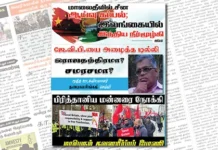Cash-strapped Sri Lanka’s economy showed “tentative signs of improvement” but recovery remains challenging and Colombo must pursue painful reforms, the IMF said Friday.
The International Monetary Fund’s Deputy Managing Director Kenji Okamura said the country was emerging from its unprecedented crisis thanks to reforms including the doubling of taxes, spending cuts and the scrapping of subsidies.
A currency crisis since late 2021 led to severe shortages of food, fuel and medicines and triggered months of protests that led to the toppling of former president Gotabaya Rajapaksa in July.
“The current economic crisis has its genesis in policy missteps aggravated by external shocks,” Okamura said in a statement Friday, after meeting President Ranil Wickremesinghe and other leaders on Wednesday.
“We discussed the importance of fiscal measures, in particular revenue measures, for a return to macroeconomic stability.”
Sri Lanka defaulted on its $46 billion external debt in April last year, and is still negotiating with its bilateral and private creditors on repayments.
“The economic recovery remains challenging,” Okamura added.
“Now, more than ever, it is essential to continue the reform momentum under strong ownership by both the authorities and the Sri Lankan people”.
Wickremesinghe, speaking to the nation on Thursday night, vowed to press ahead with restructuring loss-making state enterprises despite resistance from trade unions.
“Rebuilding a bankrupt nation cannot be achieved by using traditional methods,” Wickremesinghe said. “We must adopt a fresh approach and embark on a new journey of transformation.”
He said the state oil company, the electricity utility and national carrier Sri Lankan Airlines made losses of more than $1.32 billion in 2021, adding a huge burden on the island’s 22 million population.
Wickremesinghe’s new government secured a $2.9 billion bailout from the IMF in March under a 48-month programme that commits Colombo to painful reforms.
Foreign debt restructuring was held up as the country’s main bilateral creditor, China, was initially reluctant to take a haircut and instead offered more loans to pay off old debts.
Just over $14 billion of the total foreign credit is bilateral debt to foreign governments, 52 percent of which is owed to China.
AFP





